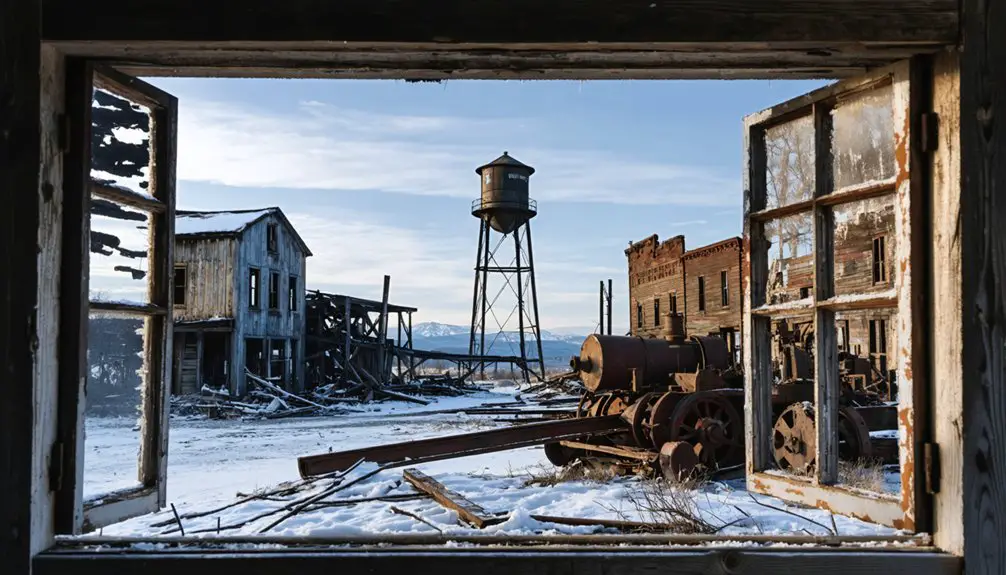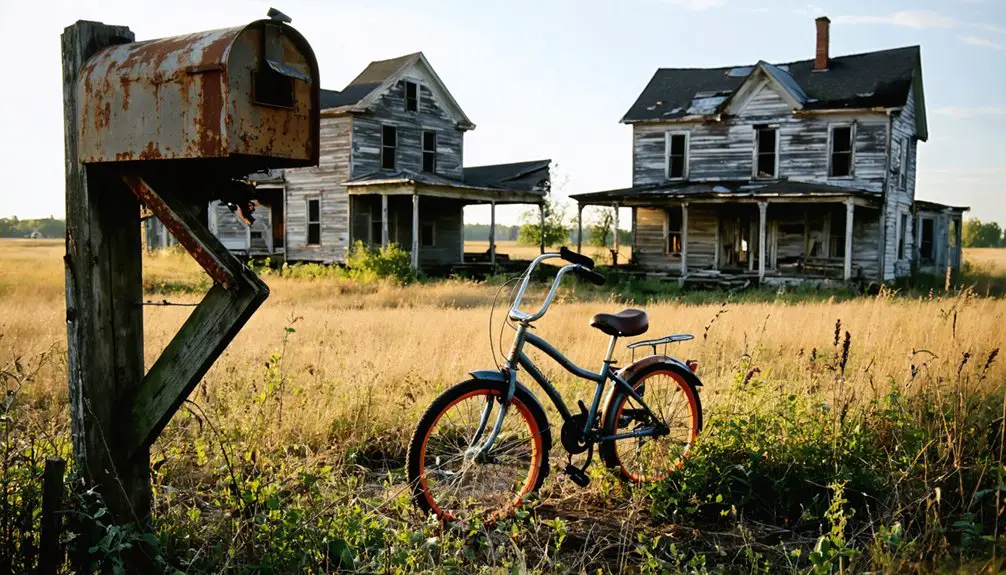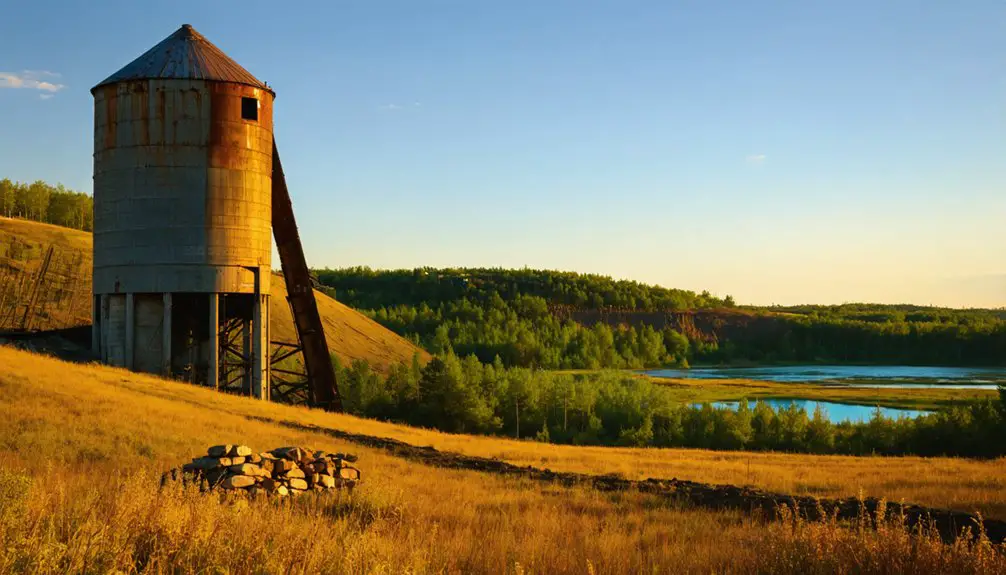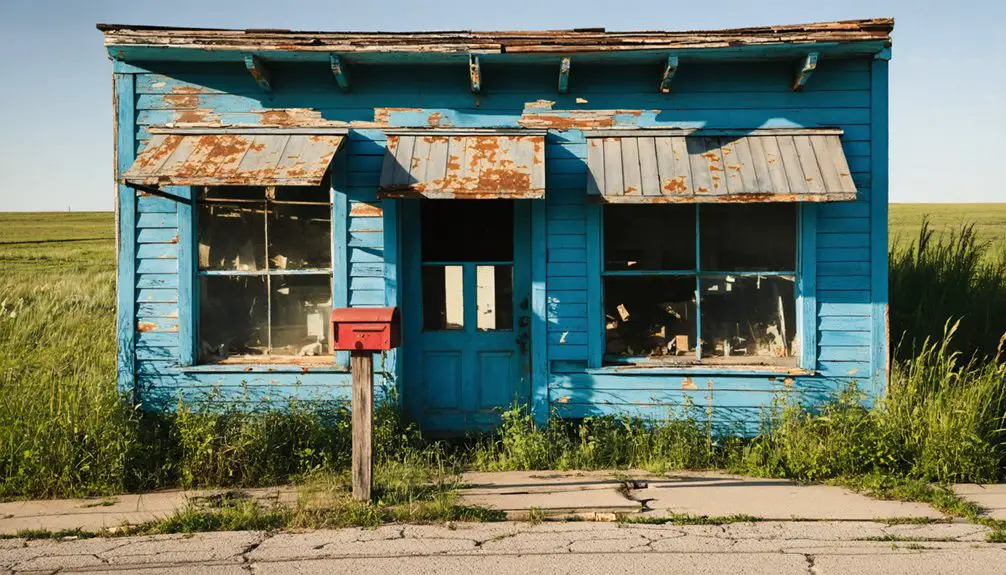You’ll discover Costin Village as a former iron mining settlement in Minnesota’s Cuyuna Range that peaked with 1,000 residents in 1907. The village bustled with immigrant miners from Finland, Austria-Hungary, and Italy, who comprised 85% of the workforce. They lived in simple wooden homes, gathering at the general store and local taverns after their shifts. While now absorbed into Mountain Iron, the village’s rich mining heritage beckons those seeking traces of America’s industrial past.
Key Takeaways
- Costin Village emerged as a mining community in Minnesota’s Cuyuna Range during the early 1900s, housing approximately 1,000 residents at its peak.
- The village’s economy centered on iron ore mining, employing immigrants from Finland, Austria-Hungary, and Italy as 85% of its workforce.
- Economic decline began as iron mines became less profitable, leading to population loss and eventual abandonment of the settlement.
- The original town structures have largely disappeared, though the site is now part of Mountain Iron at coordinates 47.53250°N, 92.62361°W.
- The ghost town’s legacy continues through historical preservation efforts and attracts interest from ghost town tourism and mining heritage enthusiasts.
The Rise of a Mining Settlement

While Minnesota’s Mesabi and Vermilion Ranges had already established their mining prowess, the Cuyuna Range emerged as a promising frontier in the early 1900s, giving birth to settlements like Costin Village.
You’d have witnessed a remarkable transformation as mining technology advanced, particularly with the innovative wash plants that separated sand from valuable iron ore in the Canisteo District.
The village sprung to life as immigrants from Finland, Austria-Hungary, Italy, and beyond flocked to the area, making up 85% of the mining workforce. The strong organized labor heritage in the region stemmed from the historic strikes of 1907 and 1916 that improved working conditions. Many relied on company housing that offered low rents but required frequent relocation as mining operations shifted.
Waves of European immigrants transformed Costin Village into a vibrant mining community, their diverse cultures shaping the workforce and local identity.
These newcomers didn’t just provide labor – they brought their cultures and traditions, weaving a rich social fabric into the community.
As rail lines extended and processing facilities multiplied, Costin Village became part of an industrial revolution that would help power America’s growth for decades to come.
Life in Early Costin Village
You’d have found daily life in early Costin Village centered around the mining shifts, with workers trudging between simple wood-frame houses and the bustling iron ore mines.
Inside these modest homes, families made do with basic amenities like wood stoves and shared water sources, while battling the harsh Minnesota winters that tested their resilience. Like the early Dakota and Ojibwe tribes who once inhabited the region, residents learned to adapt to the challenging northern climate. Similar to communities like Green Prairie Township, which had just 226 residents in 1910, Costin Village’s small population created a tight-knit atmosphere.
The community’s social fabric was woven in makeshift gathering spots, from informal camp meetings to the eventually established churches and schools that provided much-needed connection among the roughly 1,000 residents.
Daily Mining Town Routines
Life in early Costin Village revolved around the demanding rhythms of the mining industry, as workers rose before dawn to prepare for their grueling shifts underground. You’d find immigrant miners from Finland, Italy, and other European nations gathering their pickaxes and shovels, sharing brief conversations before descending into the mines.
These daily mining rituals created strong bonds of worker solidarity among the laborers who faced similar challenges. The town’s peak population reached about 1,000 people during the height of mining operations in 1907.
Throughout the day, you’d witness the coordinated efforts of extraction teams, ore sorters, and transport crews working in unison.
During breaks, miners would gather at designated areas, sharing meals and stories in their native tongues.
The company structured every aspect of daily life, from shift schedules to social activities, yet workers maintained their cultural identities through tight-knit immigrant communities.
Housing and Living Conditions
As timber from southern Minnesota’s abundant forests became the primary building material, early settlers of Costin Village constructed simple yet functional dwellings that reflected their frontier circumstances.
You’d find pioneer architecture focused on practicality, with log cabins featuring wood shingle or sod roofs and stone foundations when available. Following the rise of balloon frame construction in the 1840s, some residents began adopting this more advanced building technique. The area’s white pine logging industry provided abundant high-quality lumber for construction.
Inside these timber constructions, you’d experience communal living at its most basic – multifunctional spaces where families cooked, slept, and worked in cramped quarters lit by oil lamps and warmed by wood stoves.
Sanitation challenges and health risks were constant companions, with outhouses and communal wells defining resource management practices.
Through seasonal adaptations, you’d witness how settlers oriented their homes to maximize sunlight and shelter from harsh winds, while maintaining small gardens for self-sufficiency.
Community Gathering Places
Despite its modest size, Costin Village maintained vibrant community gathering places that formed the heartbeat of early frontier life.
You’d find residents sharing community stories at the general store or post office, while churches and schools served as central hubs for gathering traditions.
Workers often met at local taverns after their shifts, and seasonal celebrations brought everyone together in public spaces.
Like in other Minnesota towns during the era, these community spaces were essential until rural postal delivery gradually reduced the need for central gathering spots.
- The general store doubled as a social hub where locals exchanged daily news
- Churches hosted Sunday services and social hours, strengthening community bonds
- Schools transformed into venues for theatrical productions and civic meetings
- Seasonal festivals and harvest celebrations united residents in shared traditions
- Local taverns provided spaces for workers to unwind and share stories of the day
Mining Operations and Economic Growth
Iron mining transformed Minnesota’s northern frontier when commercial operations began shipping ore from the Vermilion Range in 1884, followed by the Mesabi Range in 1892 and the Cuyuna Range in 1911.
You’d have seen remarkable mining technology advancements evolve from basic picks and shovels to steam-powered equipment and mechanized shafts, dramatically improving extraction efficiency.
The immigrant workforce dynamics shaped these operations, as Europeans flocked to the mines seeking opportunities despite dangerous working conditions. The tragic Milford mine disaster claimed the lives of 41 miners when the Cuyuna Range operation flooded in 1924.
The Soudan Mine became permanently mechanized by 1924, significantly reducing the need for individual miners in the workforce.
The economic impact was profound. Mining companies established entire towns, built essential railway infrastructure, and created thousands of jobs.
When rich deposits were discovered beneath existing settlements, some towns, like Hibbing, actually relocated to make way for expanding operations.
Minnesota’s iron ranges became critical suppliers for America’s steel industry, powering the nation’s growth through two World Wars.
Daily Life and Social Structure

You’d find the wooden homes of Costin Village‘s 1,000 residents clustered near the mines, reflecting the community’s mining-focused way of life in 1907.
After long shifts underground, miners would gather at local saloons and general stores, while their families maintained households and participated in community celebrations tied to mining successes and holidays.
The social fabric wove together mining officials, skilled workers, and laborers, with family units providing stability in this northern Minnesota settlement where daily rhythms followed the demanding schedule of mine operations.
Housing and Living Conditions
Life in early 1900s Costin Village centered around modest wooden frame houses, built close together to maximize the limited space available in the growing mining community.
You’d find these simple housing styles constructed from local timber, reflecting the rapid growth driven by iron mining operations. Living conditions were basic, with most homes lacking indoor plumbing and relying on outhouses and shared wells for water.
- Most homes had minimal insulation against harsh Minnesota winters
- Families used wood-burning stoves for heating and cooking
- Dirt roads made daily travel challenging, especially during wet seasons
- Electricity was scarce or nonexistent in residential areas
- Manual labor dominated daily tasks like laundry and food preservation
The village’s housing arrangement created tight-knit neighborhoods where residents shared resources and supported each other through the challenges of mining town life.
Community Gatherings and Recreation
Despite the demanding nature of mining work, Costin Village residents found joy in regular community gatherings that brought color and warmth to their daily lives. You’d have found them congregating at the community hall for dances, sharing stories, or enjoying seasonal celebrations that marked the rhythm of village life.
Community traditions centered around both indoor and outdoor activities. In winter, you could’ve joined neighbors for ice skating and sledding, while summer brought baseball games and hiking expeditions.
The town’s social fabric was woven through various clubs and organizations, with women’s groups and fraternal societies playing key roles. Religious services and church events provided spiritual connection, while the general store served as an informal meeting spot where you’d catch up on local news and strengthen bonds with fellow villagers.
Family Roles and Work
While social gatherings brought the community together, the daily rhythms of Costin Village revolved around clearly defined family roles and work duties.
Traditional gender roles shaped family dynamics, with men laboring in mines and logging camps while women managed households and preserved food for winter.
You’d find children learning trades alongside adults, preparing for their future responsibilities in the community.
- Men worked grueling shifts underground extracting iron ore
- Women’s dawn-to-dusk routines centered on cooking, cleaning, and childcare
- Extended families shared living spaces and divided household tasks
- Children balanced schooling with helping at home and in family businesses
- Seasonal changes affected everyone’s workload, especially during peak mining times
The patriarchal structure meant fathers made key decisions, but women’s contributions in maintaining homes and organizing community care proved essential for survival.
Geographic Features and Natural Resources

Located where Mountain Iron stands today, Costin Village occupied a distinctive position within Minnesota’s Iron Range at coordinates 47°31′57″N 92°37′25″W. The settlement nestled among geological formations rich in taconite, a low-grade iron ore that would later fuel the region’s mining boom.
You’ll find the village site surrounded by the rugged natural habitat of northeastern Minnesota’s boreal forests, where mixed deciduous and coniferous trees once provided essential timber for early mining operations.
The area’s unique landscape included numerous lakes and rivers, with water covering nearly 9% of St. Louis County. You’re in a region shaped by glacial activity, where the nearby “Hill of Three Waters” serves as a remarkable hydrological divide.
The humid continental climate brought challenging winters, while Lake Superior’s influence helped moderate the temperature extremes that early settlers faced.
The Transition to Mountain Iron
As you explore the change from Costin Village to Mountain Iron, you’ll find that the merger wasn’t just a simple absorption but a gradual shift of community power and population that occurred alongside the region’s evolving mining industry.
The changing economic landscape saw Costin Village’s once-thriving population of 1,000 residents steadily move toward Mountain Iron’s expanding infrastructure and opportunities after its 1890 incorporation.
Community Merger Process
During the early 20th century, the change of Costin Village into Mountain Iron marked a significant administrative shift in Minnesota’s Iron Range. The merger motivations stemmed from the region’s mining expansion and need for centralized governance.
You’ll find that community integration happened gradually as mining operations grew and municipalities sought greater efficiency.
- The 1892 incorporation of Mountain Iron set the stage for future expansions
- Mining companies pushed for economic consolidation of smaller towns
- US Steel’s land ownership influenced boundary decisions
- State legislation encouraged mergers for better resource management
- Highway 169’s relocation impacted traffic patterns and development
The alteration brought improved municipal services to former Costin residents, while supporting the evolution from underground to open-pit mining operations.
You’ll appreciate how this merger helped create a more cohesive community structure that continues to shape the region today.
Population Shift Patterns
While Costin Village flourished with roughly 1,000 residents in 1907, its population gradually changed toward the expanding Mountain Iron settlement throughout the early 20th century.
You’ll find that demographic trends followed the promise of stable employment, as larger mining companies invested heavily in Mountain Iron’s infrastructure. The migration patterns reflected practical choices – families moved where they’d find better schools, medical facilities, and reliable work opportunities.
The change maintained the area’s strong European immigrant character while concentrating the population in Mountain Iron’s growing urban center.
If you’d visited during this change, you’d have witnessed younger workers leading the exodus, drawn by Mountain Iron’s industrial development and improved transportation networks.
This steady population movement eventually led to Costin Village’s complete absorption into Mountain Iron’s boundaries.
Economic Power Transfer
The 1890 discovery of rich hematite ore deposits in Mountain Iron sparked an economic revolution that reshaped the region’s destiny.
You’ll find this economic transformation shifted power from the Vermilion Range to the Mesabi Range, as mining innovations enabled more efficient ore extraction through surface mining. Eastern industrialists from Pittsburgh and Cleveland quickly seized control, establishing their economic dominance while managing operations from afar.
- Over 60 mining companies incorporated in Minnesota between 1887-1889
- The Duluth, Missabe and Iron Range Railway became essential for ore transport
- Mining methods evolved from underground to open-pit operations
- Company towns emerged to house and control the workforce
- Outside ownership influenced local development and labor relations
During this pivotal period, you’d have witnessed Mountain Iron’s rise as the epicenter of Minnesota’s iron industry, fundamentally altering the region’s economic landscape and industrial future.
Notable Figures and Local Leaders
Pioneer entrepreneur John Costin stands as the singular notable figure in Costin Village’s brief but impactful history.
As the town’s founder and driving force, he shaped local governance through his vision of establishing a thriving mining community in what would later become Mountain Iron, Minnesota. You’ll find his influence reflected in the village’s rapid growth to nearly 1,000 residents by 1907.
Historical documentation reveals a striking absence of other prominent leaders during the village’s existence.
Records show a remarkable void of influential figures in the village’s leadership beyond its founder.
Unlike many Minnesota settlements, you won’t discover records of indigenous chiefs, military commanders, or competing political figures who shaped the community.
Instead, Costin’s entrepreneurial leadership remained the dominant force, focusing primarily on mining operations and community development in the early 1900s.
Infrastructure and Development

Under John Costin’s leadership, infrastructure development quickly took shape to support the growing settlement.
You would’ve witnessed the village transform as streets were graded and basic housing emerged, accommodating over 1,000 residents drawn to opportunities from the nearby dam project.
Despite infrastructure challenges, the village thrived with power from the hydroelectric plant built in 1914.
- Streets laid out within the first year of dam construction
- Power supplied by the Mississippi River hydroelectric plant
- Rail access connecting to regional transportation networks
- Water resources managed through dam infrastructure
- Modern utilities including water storage and distribution
The development impacts rippled through the region as Costin Village integrated into broader energy and transportation networks.
The Great Northern Development Company‘s dam project, managed by successive power companies until 1969, remained central to the village’s industrial and domestic life.
The Decline and Abandonment
While mining operations initially fueled Costin Village’s growth, economic shifts in the early 20th century marked the beginning of its decline. As the iron mines became less profitable, economic migration swept through the community, with residents seeking opportunities elsewhere.
You’d have seen transportation impacts worsen as railroads bypassed the village, isolating it from essential commerce routes.
The town’s fate was sealed by a perfect storm of challenges: demographic changes reduced the population from 1,000 in 1907, social disintegration followed as services disappeared, and environmental challenges from harsh winters made survival difficult.
Political neglect and resource depletion left the remaining residents with few options. Without support for rural development and faced with community decline, families gradually abandoned their homes, leaving Costin Village to fade into history.
Historical Legacy and Modern Remnants

Today, Costin Village’s legacy endures primarily through historical records and its incorporation into Mountain Iron, Minnesota.
You’ll find its coordinates at 47.53250°N and 92.62361°W, where this once-thriving mining community played an essential role in Minnesota’s industrial expansion.
The village’s cultural significance lives on through historical preservation efforts and its contribution to the Mesabi Iron Range‘s mining heritage.
- Original town structures have largely vanished, leaving potential archaeological evidence
- Local museums and historical markers preserve the community’s mining heritage
- Geographic databases recognize it as a significant former populated place
- Mining innovations, including open pit techniques, shaped regional development
- Ghost town tourism and historical research continue to draw enthusiasts interested in vanished mining communities
Frequently Asked Questions
What Indigenous Tribes Originally Inhabited the Land Where Costin Village Stood?
Like ancient footprints in sacred soil, you’ll find the Ojibwe people were the primary inhabitants of this land, while Dakota had periodic presence. The area holds deep tribal history and spiritual significance.
Were There Any Major Accidents or Disasters in Costin Village’s Mining Operations?
While there’s no record of major mining accidents at Costin Village specifically, you’ll find the region’s most devastating disaster was the nearby Milford Mine collapse in 1924, which claimed 41 miners’ lives.
What Happened to the Cemetery and Burial Grounds of Costin Village?
Like 40% of abandoned town burial grounds, you’ll find the cemetery suffered from neglect. The burial grounds merged with surrounding farmland, though occasional grave markers and traditional cemetery plantings still hint at its location.
Did Any Famous People or Celebrities Ever Visit Costin Village?
You won’t find any documented famous visitors or celebrity sightings in the village’s history. Its remote location and short-lived existence as a mining community didn’t attract well-known personalities.
What Artifacts or Personal Items Have Been Recovered From Costin Village?
You’ll find artifacts including stone tools, glass beads, pottery sherds, liquor flasks, and personal items like prescription bottles, boot polish containers, and toothpick holders from late 19th to early 20th century.
References
- https://racketmn.com/ghost-towns-minnesota-hennepin-county
- http://wikimapia.org/14573356/Former-town-of-Costin-MN-Site
- https://en.wikipedia.org/wiki/Costin_Village
- http://freepages.rootsweb.com/~gtusa/history/usa/mn.htm
- https://en.wikipedia.org/wiki/List_of_ghost_towns_in_Minnesota
- https://www.lrl.mn.gov/docs/pre2003/other/781145.pdf
- https://www3.mnhs.org/mnopedia/search/index/place/mesabi-iron-range
- https://www.youtube.com/watch?v=5BCaA3IgUGE
- https://hibbinghistory.org/wp-content/uploads/2017/10/The_Locations_by_Arnold_Alanen_1982_Carson_Lake_pg_96_99_103.pdf
- https://www3.mnhs.org/mnopedia/search/index/immigration-iron-range-1880-1930



